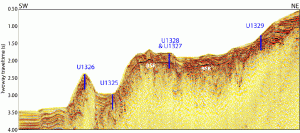Overview
Gilles Guerin, Alberto Malinverno

Figure 1. A location of IODP Expedition 311 on the Cascadia margin. B) Bathymetry and location of the different sites visited (bathimetry courtesy of D. Kelley, J. Delaney, and D. Glickson, University of Washington, and C. Barnes, C. Katnick, NEPTUNE Canada, University of Victoria; funded by the University of Washington and the W.M. Keck Foundation.
Expedition 311 of the Integrated Ocean Drilling Program (IODP) investigated the occurrence and the formation of gas hydrate in the accretionary prism of the northern Cascadia margin. The five sites visited during the expedition defined a SW-NE transect across a ~30km wide Bottom Simulating Reflector (BSR) that runs parallel to the coast along most of the continental slope (see Figure 1).
From Site U1326, at the SW tip of the accretionary prism, to Site U1329, the shallowest site located at the landward limit of the BSR, the transect was designed to sample the complexity of the evolution of a gas hydrate system (see Figure 2).
To constrain the formation of gas hydrates in subduction zones, Expedition 311 had an ambitious drilling program including extensive pressure coring to recover gas hydrate at in situ conditions. Because of the unstability of gas

Figure 2. Seismic section (line 89-08) showing the position of the Expedition 311 sites across the accretionary front.
hydrate at surface conditions, and of the strong response of some logging tools such as electrical and acoustic logs to the presence of gas hydrate, logging was a critical component of the operations. The logging program consisted of two phases – the first week of the expedition was dedicated to Logging While Drilling (LWD), in order to identify intervals likely to contain gas hydrate where pressure coring tools should be deployed; the second phase consisted in wireline logging following coring operations in order to complete the geophysical characterization of the sites.
Related Links
Logging Data
